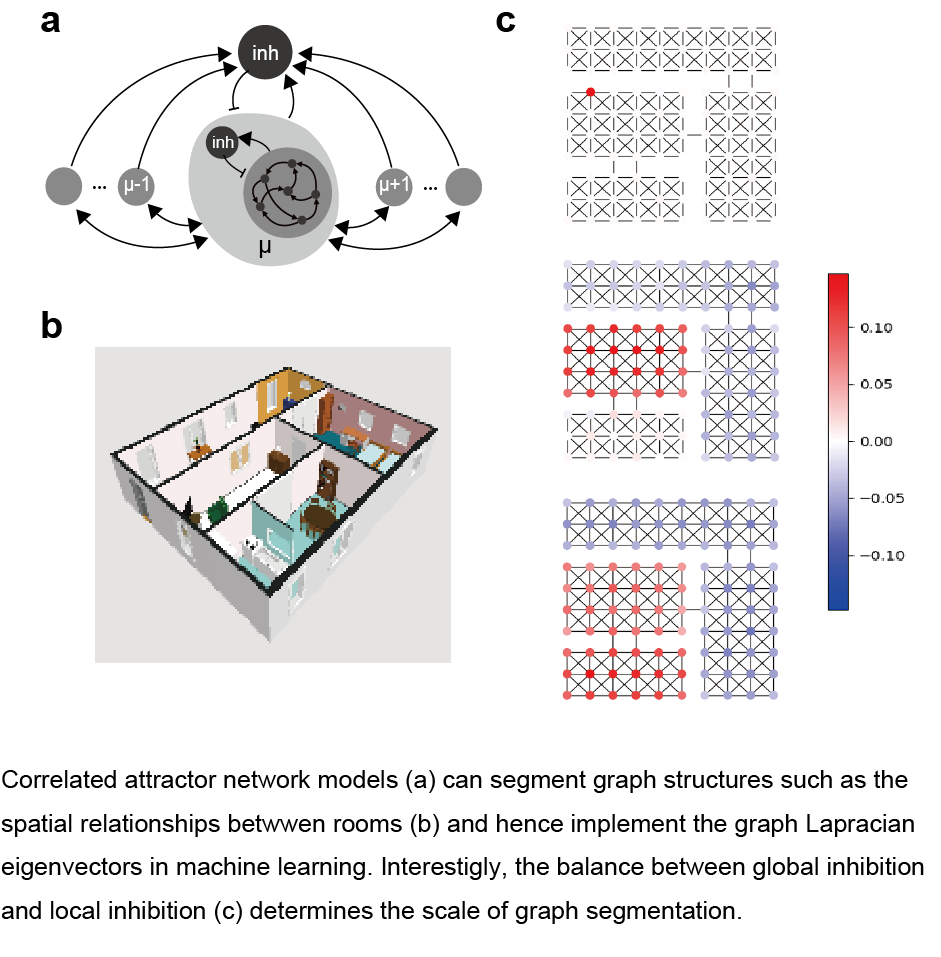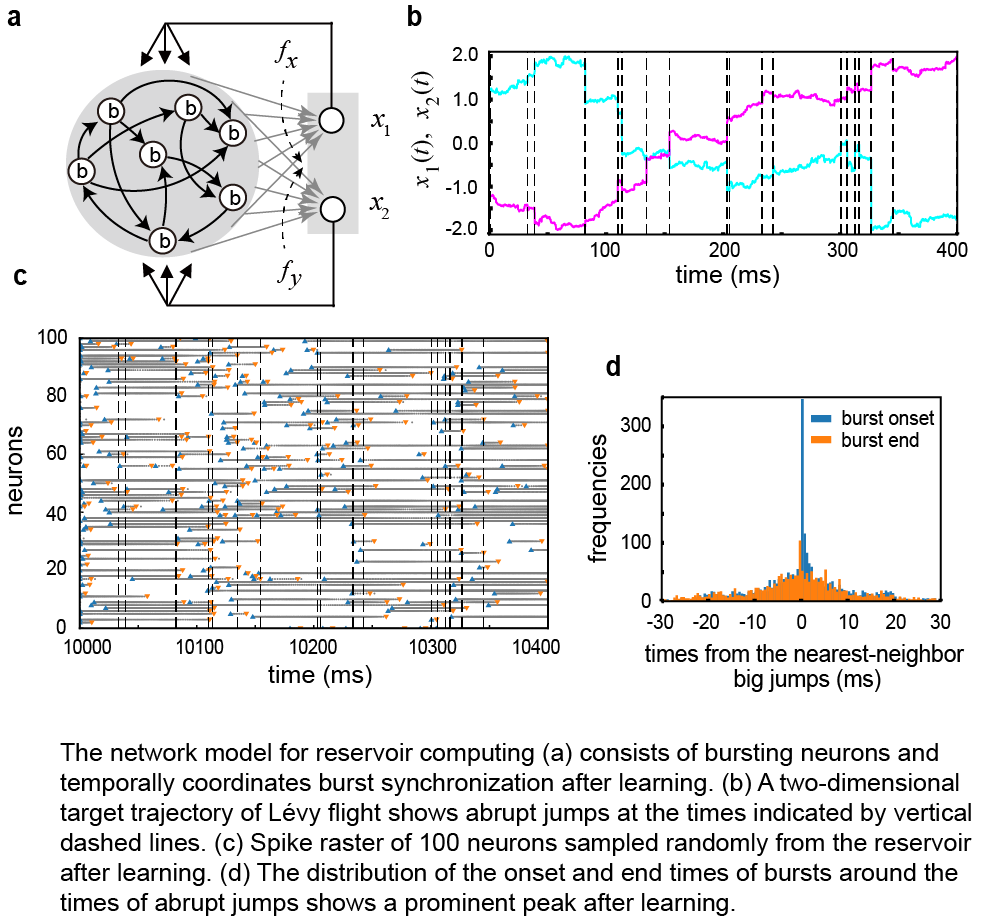Neural Coding and Brain Computing Unit
Professor Tomoki Fukai
Abstract
This unit has been exploring the brain's neural mechanisms underlying cognitive functions, especially learning and memory. We are interested in clarifying how neural networks in the brain integrate single-cell computation such as dendritic computation with network-level computation to generate higher cognitive functions. In recent years, we focussed on how the brain segments potentially important pieces of information from continuous streams of sensory input. We will use our findings for modeling the brain mechanisms of not only memory processing but also inference and language processing.
1. Staff
- Staff Scientist
- Chi Chung Fung, PhD
- Tatsuya Haga, PhD
- Postdoctoral Scholar
- Ibrahim Alsolami, PhD
- Hongjie Bi, PhD
- Toshitake Asabuki, PhD
- Milena Menezes Carvalho, PhD
- Research Unit Technician
- Ruxandra Cojocaru, PhD
- Ph.D. Student
- Thomas Burns
- Gaston Sivori
- Maria Astrakhan
- Roman Koshkin
- Munenori Takaku
- Hugo Musset
- Balashwethan Chockalingam
- Rotation Student
- Balashwethan Chockalingam (Term 3)
- Prajakta Kokate (Term 3)
- Taisuke Higuchi (Term 1)
- Christian Amor Rodriguez (Term 2)
- Research Intern
- Yuta Konno (Jan-Apr 2022)
- Research Unit Administrator
- Kiyoko Yamada
2. Collaborations
2.1 "Idling Brain" project
kaken.nii.ac.jp/en/grant/KAKENHI-PROJECT-18H05213
- Supported by Grant-in-Aid for Specially Promoted Research (KAKENHI)
- Type of collaboration: Joint research
- Researchers:
- Professor Kaoru Inokuchi, University of Toyama
- Dr. Khaled Ghandour, University of Toyama
- Dr. Noriaki Ohkawa, University of Toyama
- Dr. Masanori Nomoto, University of Toyama
2.2 Chunking sensorimotor sequences in human EEG data
- Type of collaboration: Joint research
- Researchers:
- Professor Keiichi Kitajo, National Institute for Physiological Sciences
- Dr. Yoshiyuki Kashiwase, OMRON Co. Ltd.
- Dr. Shunsuke Takagi, OMRON Co. Ltd.
- Dr. Masanori Hashikaze, OMRON Co. Ltd.
2.3 Cell assembly analysis in the songbird brain
- Type of collaboration: Internal joint research
- Researchers:
- Professor Yoko Yazaki-Sugiyama, OIST
- Dr. Jelena Katic, OIST
2.4 A novel mathematical approach to partially observable Markov decision processes
- Type of collaboration: Joint research
- Researchers:
- Haruki Takahashi, PhD student, Kogakuin University
- Prof. Takashi Takekawa, Kogakuin University
- Prof. Yutaka Sakai, Tamagawa University
3. Activities and Findings
3.1 The Brain Mechanisms of learning hierarchical information
Information about the environment is hierarchically organized in spatial and temporal dimensions, so is our knowledge formed about the environment. Cognitive functions of the brain rely on its ability to analyze these hierarchies, and the identification of meaningful segments of spatial and temporal information is thought to underly this analysis of the brain. In the previous year, we proposed a self-supervising learning rule to implement unsupervised temporal segmentation in single neurons (Asabuki and Fukai, Nat Comm 2020). This year, we extended the proposed learning rule to more complex segmentation tasks in network models with gated recurrent synaptic input (Asabuki and Fukai, bioRxiv 2021). In parallel, we proposed a class of neural network models that perform graph-based segmentation of hierarchically organized information (Haga and Fukai, PLoS Comput Biol 2021) (Fig.1). We published a review paper on these segmentation mechanisms (Fukai, Asabuki, and Haga, Curr Opin Neurobiol, 2021).

3.2 Learning and computing with spike bursts
Isolated spikes and bursts of spikes are thought to provide the two major modes of information coding by neurons. However, whether and how bursts have an advantage over isolated spikes in the network-level computation remains elusive. In this study, we used reservoir computing to demonstrate the advantage of spike bursts over isolated spikes in learning movement trajectories representing Lévy flight, which is a hallmark of optimal search strategies (Ohta et al., Sci Rep 2021). Our results suggest that bursting is crucial for sequence learning by recurrent neural networks when sequences comprise long-tailed distributed discrete jumps. We revealed that the network model synchronizes bursts of the individual neurons around the times of abrupt jumps in such trajectories (Fig. 2). The first author of the paper was an out-field rotation student with a physics background.

3.3 Studies with experimental collaborators
We have published two papers through our collaborators with RIKEN. The Goda laboratory discovered that glia cells regulate the variance in short-term depression across synaptic transmissions from single cortical neurons. We clarified the computational implications of this finding in a computational model of synaptic plasticity (Chipman et al., eLife 2021). In the collaboration with the Okamoto laboratory, we detected the activity patterns of neural ensembles in calcium imaging data recorded from zebrafish to explore the neural mechanism of escape behavior. Our results were consistent with the predictive coding hypothesis for the brain’s hierarchical information processing (Torigoe et al., Nat Comm, 2021).
4. Publications
4.1 Journals
- Morihiro Ohta, Toshitake Asabuki and Tomoki Fukai (2022) Intrinsic bursts facilitate learning of Lévy flight movements in recurrent neural network models. Scientific Reports, 12, 4951, DOI: https://doi.org/10.1038/s41598-022-08953-z
- Tomoki Fukai, Toshitake Asabuki and Tatsuya Haga (2021) Neural mechanisms for learning hierarchical structures of information. Curr Opin Neurobiol, 70, 145-153, https://doi.org/10.1016/j.conb.2021.10.011.
- Peter H. Chipman, Chi Chung Alan Fung, Alejandra Pazo Fernandez, Abhilash Sawant, Angelo Tedoldi, Atsushi Kawai, Sunita Ghimire Gautam, Mizuki Kurosawa, Manabu Abe, Kenji Sakimura, Tomoki Fukai and Yukiko Goda (2021) Astrocyte GluN2C NMDA receptors control basal synaptic strengths of hippocampal CA1 pyramidal neurons in the stratum radiatum.eLife, 10:e70818, DOI: 10.7554/eLife.70818
- Makio Torigoe, Tanvir Islam, Hisaya Kakinuma, Chi Chung Alan Fung, Takuya Isomura, Hideaki Shimazaki, Tazu Aoki, Tomoki Fukai and Hitoshi Okamoto (2021) Zebrafish capable of generating future state prediction error show improved active avoidance behavior in virtual reality. Nat Commun, 12, 5712. https://doi.org/10.1038/s41467-021-26010-7
- Tatsuya Haga, Tomoki Fukai (2021) Multiscale representations of community structures in attractor neural networks. PLoS Comput Biol 17(8): e1009296. https://doi.org/10.1371/journal.pcbi.1009296
- Takashi Handa, Rie Harukuni, Tomoki Fukai (2021) Concomitant processing of choice and outcome in frontal corticostriatal ensembles correlates with performance of rats. Cerebral Cortex (online advance article), bhab091, DOI: https://doi.org/10.1093/cercor/bhab091
4.2 Books and other one-time publications
- Tomoki Fukai (2022) 樹状突起計算を統合する新しい回路学習パラダイムの創出(Japanese). KAKENHI Project (AI & Brain Science) News Letter, vol. 10: 14. http://www.brain-ai.jp/jp/newsletter/
4.3 Oral and Poster Presentations
Oral Presentations
- Tomoki Fukai. Extracting Cell Assembly Patterns from Large-scale Recording Data. Grant-in-Aid for Transformative Research Areas Symposium:Morphological Features and Gene Expression Patterns in Hub Neurons (Kanazawa, Japan) (March 26, 2022)
- Tomoki Fukai. Old and new findings on cell-assembly hypothesis. The University of Electro-Communications (Fuchu, Japan)(December 24, 2021)
- Thomas F Burns, Tatsuya Haga and Tomoki Fukai. Multiscale and extended retrieval of associative memory structures in a cortical model of local-global inhibition balance. Neuromatch 4.0, Online (December 1-2, 2021)
- Tomoki Fukai. What can neural network models tell about brain activity: two separate strata in the cortex? RIKEN-OIST Joint Symposium Series 2 "Kinds of Minds - what is thinking?" , Online (Wako/Onna, Japan) (October 6, 2021)
- Toshitake Asabuki and Tomoki Fukai. Learning hierarchical and probabilistic input structures in neural networks. “Topical Problems of Nonlinear Wave Physics” (NWP-2021), Online (Russia) (September 20, 2021)
- Tomoki Fukai. Plenary Symposium: Synaptic Plasticity and Emergent Functions (Chair: Masami Tatsuno), 14th Canadian Neuroscience Meeting, Online (Canada) (August 23, 2021)
- Tomoki Fukai. Neural mechanisms of segmentation in sensory and memory processing. Connecting Brains: A worldwide Neuroscience Lecture Series (Max Planck Institute for Brain Research), Online (Germany) (June 8, 2021)
Poster Presentations
- Toshitake Asabuki and Tomoki Fukai. Learning spontaneously reactivatable prior distributions for causal inference. RIKEN-OIST Joint Symposium Series 2 "Kinds of Minds - what is thinking?" , Online (Wako/Anna, Japan) (October 7, 2021)
- Roman Koshkin and Tomoki Fukai. Role of Spontaneous Neural Activity in Memory Function. RIKEN-OIST Joint Symposium Series 2 "Kinds of Minds - what is thinking?" , Online (Wako/Anna, Japan) (October 7, 2021)
- Tomoki Fukai, Ruxandra Cojocaru and Takashi Takekawa. Assemblies of low-frequency firing neurons in the motor cortex of behaving rats. The 44th Annual Meeting of the Japan Neuroscience Society/The 1st CJK International Meeting, Online (Kobe, Japan) (July 31, 2021)
- Gaston Sivori, Toshitake Asabuki and Tomoki Fukai. Biologically-realistic self-supervised pattern turning by somato-dendritic coupling modulation. IBRO-RIKEN CBS Summer Program 2021, Online (Wako, Japan) (June 28-July 2, 2021)
4.4 Seminars
- Thomas F Burns. Applied algebra in neuroscience. Talk at Department of Mathematics, University of Mataram, Indonesia (online) (February 2022)
- Thomas F Burns. Detecting Danger in Gridworlds using Gromov's Link Condition. Lecture at University of Mataram, Indonesia (February 2022)
- Thomas F Burns. Breaking the wall of neural networks. Talk at Falling Walls Lab Sendai 2021 (online) (August 2021) (Finalist in Japan-wide competition)
- Thomas F Burns. Euthanasia, autonomy, and public health emergencies. Lecture at Roosevelt University, USA (April 2021)
5. Intellectual Property Rights and Other Specific Achievements
5.1 Grants
Kakenhi Grant-in-Aid for Specially Promoted Research
- Titile: Mechanisms underlying information processing in idling brain
- Period: FY2018-2022
- Principal Investigator: Prof. Kaoru Inokuchi (University of Toyama)
- Co-Investigators: Prof. Tomoki Fukai, Prof. Keizo Takao (University of Toyama)
Kakenhi Graint-in-Aid for Early-Career Scientists
- Titile: A Comprehensive Theoretical Survey on Functionalities and Properties of Adult Neurogenesis under the Influence of Slow Oscillations
- Period: FY2019-2022
- Principal Investigator: Dr. Chi Chung Fung
Kakenhi Graint-in-Aid for Early-Career Scientists
- Titile: Modeling neural language processing by attractor networks
- Period: FY2021-2023
- Principal Investigator: Dr. Tatsuya Haga
5.2 Awards
- Roman Koshkin. The Google AI PhD Fellowship (September 2021)
6. Meetings and Events
Nothing to report.
7. Other
- Tomoki Fukai. Reviewer at Computational and Systems Neuroscience (Cosyne 2022), Lisbon, Portugal (March 17-20, 2022)
- Tomoki Fukai. Program Committee, The 44th Annual Meeting of the Japan Neuroscience Society, Kobe, Japan (July 28-31, 2021)
- Milena Menezes Carvalho and Roman Koshkin: Mentor in The Okinawa Science Mentoring Program (OSMP) 2021




